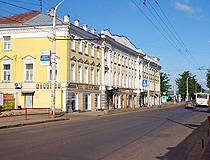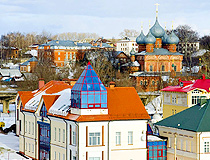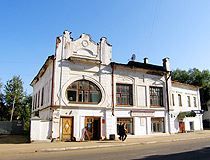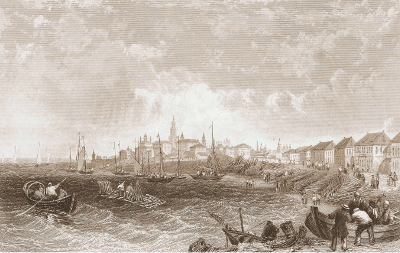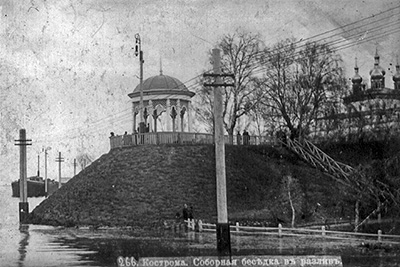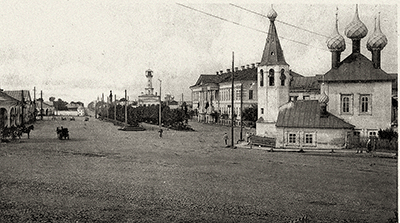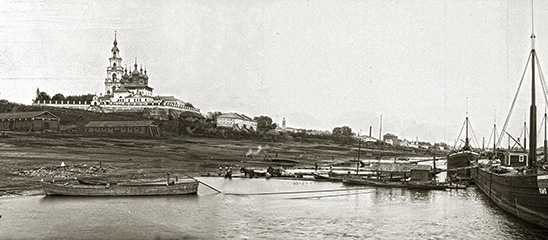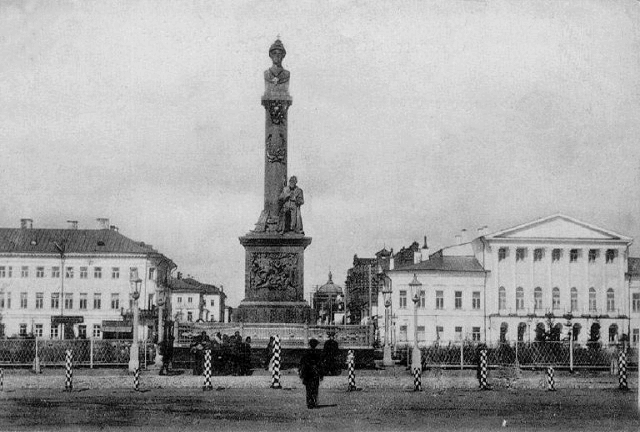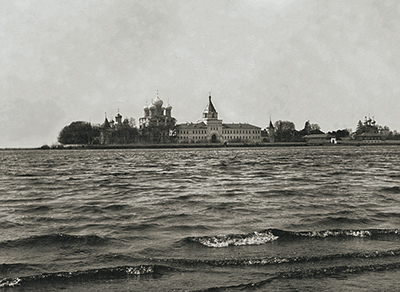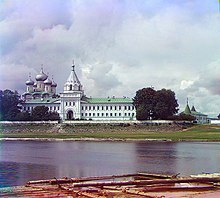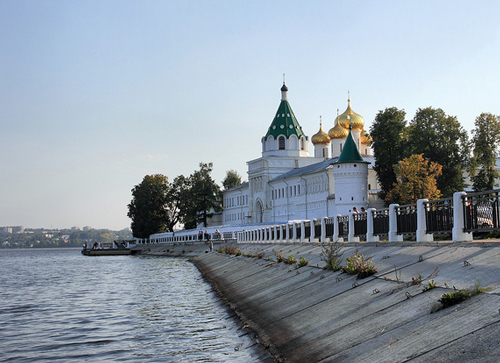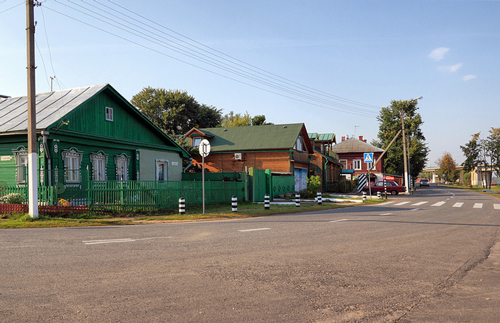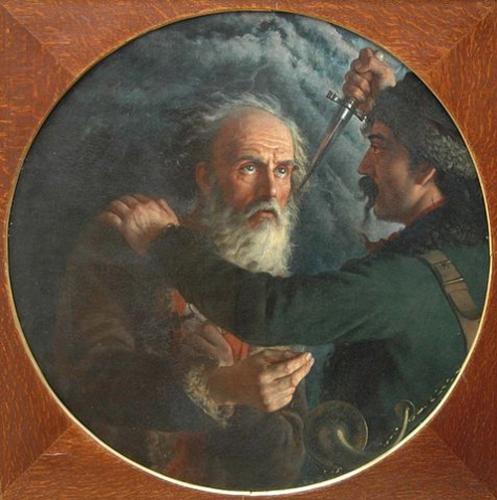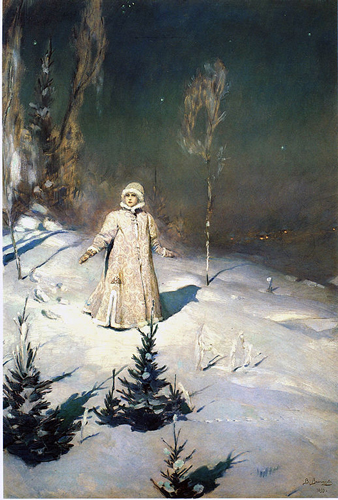Кострома у большинства людей ассоциируется с древнерусской историей и народным фольклором.
Kostroma in most people is associated with the ancient Russian history and folk folklore.
Еще на ум приходят костромской сыр, Иван Сусанин и река Волга, на которой стоит этот древний город.
Still on mind come Kostroma cheese, Ivan Susanin and the Volga River, on which stands this ancient city.
Возраст Костромы действительно почтенный, она всего на 5 лет младше Москвы.
The age of Kostroma is really respectable, it is only 5 years younger than Moscow.
Город был заложен князем Юрием Долгоруким в середине XII века.
The city was founded by Prince Yuri Dolgoruky in the middle of the 12th century.
Это был город-крепость, расположенный в месте впадения в Волгу реки Костромы, и имеющий важное стратегическое значение в междоусобных войнах русских князей.
It was a fortified city, located at the confluence of the Kostroma River in the Volga, and having an important strategic significance in the internecine wars of the Russian princes.
Поляки, которые хотели уничтожить претендента на престол, оказались в опасной близости от места укрытия
The Poles, who wanted to destroy the applicant for the throne, were in dangerous proximity to the place of shelter
Их проводником к месту нахождения наследника стал местный крестьянин Иван Сусанин, который завел отряд в непроходимое болото, за что был убит поляками.
Their guide to the location of the heir was a local peasant Ivan Susanin, who led the detachment into an impenetrable swamp, for which he was killed by the Poles.
Этот подвиг простого русского крестьянина вошел во все учебники истории, и был официально признан образцом доблести и патриотизма русского народа.
This exploit of a simple Russian peasant entered all history textbooks, and was officially recognized as a model of the valor and patriotism of the Russian people.
Костромские купцы и промышленники создали в городе мощный экономический фундамент, способствуя его дальнейшему развитию и росту благосостояния горожан.
Kostroma merchants and industrialists created a powerful economic foundation in the city, contributing to its further development and the growth of the well-being of the townspeople.
Сегодня, Кострома – областной центр, с колоритом и размеренностью купеческого города.
Today, Kostroma is a regional center, with the color and dimension of the merchant city.
Еще с XV века, она славилась золотых дел мастерами, а сегодня является ювелирной столицей России.
Since the XV century, it was famous for goldsmiths, and today it is the jeweler capital of Russia.
Также в Костроме активно развивается мебельное производство.
Also, in Kostroma, furniture manufacturing is actively developing.
Из крупных предприятий – фабрика с богатой историей «Костромамебель», известная на всю страну.
Of the large enterprises – a factory with a rich history of “Kostromaemebel”, known throughout the country.
Кострома входит в туристический маршрут Золотого кольца России.
Kostroma is included in the tourist route of the Golden Ring of Russia.
Интересные достопримечательности:
Interesting attractions:
– Ипатьевский монастырь
– Ipatievsky Monastery
– Музей деревянного зодчества – музей расположен в живописном месте, обстановкой и пейзажем напоминающем русскую сказку.
– The Museum of Wooden Architecture – the museum is located in a picturesque place, with a setting and a landscape reminiscent of a Russian fairy tale.
– Центральная площадь сковородка с пожарной каланчой – это талисман города, в былые времена не раз спасавший его от полного уничтожения пожарами.
– The central area of a frying pan with a fire tower is a talisman of the city, which in times gone by rescued it from complete destruction by fires.
– Торговые ряды – они сохранили свой вид с момента постройки в XVIII веке. Это целый архитектурный ансамбль, создающий иллюзию купеческой жизни в современном городе.
– Trading rows – they have kept their appearance from the moment of construction in the XVIII century. It is an architectural ensemble creating the illusion of merchant life in a modern city.
– Терем Снегурочки – место, где обитает вечно юная красавица, входит в состав целого комплекса тематических построек, призванных пробудить в детях и взрослых веру в чудеса.
– The Snowmobile Terem – the place where the eternally young beauty dwells, is part of a whole complex of thematic buildings designed to awaken in children and adults faith in miracles.
В окрестностях Костромы полно живописных мест в лесах, на берегах и заливах Волги.
In the vicinity of Kostroma there are many picturesque places in the forests, on the banks and bays of the Volga.
Воды могучей реки, которым нет конца и края, окружены зелеными лесами.
The waters of a mighty river, with no end and no end, are surrounded by green forests.
Это выглядит очень внушительно и живописно.
It looks very impressive and picturesque.
History of Kostroma
Foundation of Kostroma
Kostroma is an old Russian city with a rich, eventful history. The date of foundation of Kostroma is officially considered to be 1152. This date was proposed by the historian Vasily Tatishchev, who associated this event with the activities of Yuri Dolgorukiy (Grand Prince of Kiev) in the north-east of Russia. However, there are no reliable sources proving this date. The hypothesis according to which Kostroma was founded much earlier, in the middle of the 9th century, doesn’t have scientific support as well.
The first written mention of the existence of Kostroma dates back to 1213. This year, Rostov Prince Konstantin burned Kostroma, which supported his brother Yuri (Vladimir Prince). In the 13th-14th centuries, fortified monasteries arose around Kostroma protecting the approaches to the town: the Ipatiev Monastery and the Nikolo-Babaevsky Monastery.
In 1364, Kostroma became part of the Moscow Principality. The location of this fortified town near the confluence of the Kostroma River in the Volga provided control over the Volga route and the route to the north along the Kostroma River, as well as over the local salt springs.
The wooden town was often subjected to attacks by Novgorod pirates. Therefore, in 1419, it was moved to a new elevated place, which became known as the Kostroma Kremlin. The first stone building in Kostroma was built here — the Assumption Cathedral.
More Historical Facts…
Kostroma in the 17th-19th centuries
In 1613, in the Ipatiev Monastery, Mikhail Fedorovich Romanov was called to reign, which was the end of such a period in the history of Russia as the Time of Troubles (Smuta). Thus, Kostroma became the “cradle” of the imperial Romanov dynasty.
By the middle of the 17th century, Kostroma, in its economic development and number of residents, became the third largest town of the Russian state after Moscow and Yaroslavl with well-developed textile, leather, soap making, silver, and icon painting industries. Blacksmithing, pottery, construction industries were also developed. Kostroma became a large trading center. In the second half of the 17th century, an outstanding school of fresco and icon painting was formed in Kostroma.
In 1708, Kostroma became a provincial town of Moscow Governorate. In 1767, Catherine II approved the coat of arms of Kostroma with the image of the galley “Tver”, on which she arrived in Kostroma. Kostroma became the first town in Russia to receive its own coat of arms.
From the middle of the 18th century, the development of Kostroma as a textile center began. In terms of the volume of linen fabric produced, Kostroma quickly came out on top in Russia. There were also 12 tanneries and 18 brick factories, 6 cloth manufactories, and other factories. Kostroma became a major river port on the Volga transit route. In 1781, the master plan for the development of Kostroma with stone buildings was approved. In 1796, by decree of Emperor Paul I, it became the administrative center of a separate Kostroma Governorate.
In 1811, the population of Kostroma was about 10,000 people. In 1870, the first water supply system was built in Kostroma. In 1891, the Museum of Antiquities was opened. In 1894, there were 36 churches in Kostroma. The population of the city was 33,012 people. In 1895, the first five-story building was constructed in Kostroma (a dormitory for workers and employees of the Novo-Kostroma Linen Manufactory Partnership).
Kostroma in the 20th century and beyond
In 1913, Kostroma became one of the centers of celebrations in honor of the Romanov Tercentenary. For this event, a power station was built in the city, the second stage of the water supply system was opened, the foundation of a grandiose monument to the 300th anniversary of the Romanov dynasty was laid, a number of civil buildings were built, including the Romanovsky Museum and the Romanovskaya Hospital. The population of the city was about 48,000 people.
On January 14, 1929, Kostroma Governorate was abolished. Kostroma lost the status of a regional center and was included first in Ivanovo and then Yaroslavl oblast. Industrialization in Kostroma was a forced development of textile, light, and wood processing enterprises, as well as textile machinery.
In 1932, the construction of a railway bridge over the Volga River was completed. By the end of the 1930s, the population almost doubled due to the influx of labor from peasants. In 1932, a textile institute was opened, in 1939 — a teacher’s institute.
In the 1930s, a lot of churches were destroyed or rebuilt in Kostroma. The Kostroma Kremlin was completely demolished in 1934. A huge monument was erected on the resulting wasteland to Vladimir Lenin. At the base of the statue was a pedestal, which had been laid in honor of the celebration of the 300th anniversary of the Romanov House.
In 1939, the population of Kostroma was 121,325 people. During the Second World War, hospitals, military schools, and the civilian population were evacuated to Kostroma. On August 13, 1944, the city of Kostroma became the administrative center of the newly formed separate Kostroma Oblast.
In the 1950s-1980s, in Kostroma, in addition to the textile and woodworking industries, new industries were intensively developed: power engineering, machine building and metalworking, radio electronics and instrument making. Intensive industrial and housing construction was carried out at this time: new industrial zones and residential micro-districts were formed.
Tourism infrastructure also began to develop. In 1958, a historical and architectural museum-reserve was organized on the basis of the Ipatiev Monastery. In the 1960s, behind the southern wall of the monastery along the left bank of the Igumenka River, a museum complex of wooden architecture was formed.
In 1970, the auto-pedestrian bridge across the Volga was opened. In 1987, the Citi Day of Kostroma was celebrated for the first time, which coincided with its 835th anniversary. In 1989, about 278,000 people lived in Kostroma.
In 2003-2010, a large-scale campaign to improve the city was carried out. Among other things, a pedestrian zone was organized along the Volga embankment; Susaninskaya Square, Mira Square, and the boulevard part of Mira Avenue were reconstructed, a lot of monuments and sculptures were installed.
Architecture of Kostroma
On the street in Kostroma
Kostroma cityscape
Author: Yuriy Chulkov
Picturesque old building in Kostroma
Author: Alena Amplieva
Kostroma — Features
Kostroma is one of the oldest Russian cities with a rich historical and cultural heritage. This city is a unique monument of Russian urban planning of the 16th-19th centuries with a lot of monuments of architecture and history. It is one of the Russian cities that have preserved, in general, its architectural appearance. The Volga River, dividing the city into two parts, gives it special beauty and attractiveness.
This city has an unusual street layout: they fan out from the Volga embankment. There is a legend that Catherine II ordered the court architects to develop a city plan for Kostroma. None of the projects satisfied her. Then one of the architects asked what, in her opinion, this city should look like. Catherine spread her fan, which she held in her hands, and said: “Here is an example”.
The name “Kostroma” is explained by historians in different ways. According to one version, the city was named after the Kostroma River, on the banks of which it stands. According to another version, the name may be associated with one of the characters of peasant beliefs — Kostroma — a straw scarecrow usually burned with the advent of spring. The most popular version refers to the times when on the banks of the Volga River people built large “kostry” (“bonfires”) of tree trunks, which were later rafted down the river.
The climate is temperate continental. The average temperature in January is minus 10.9 degrees Celsius, in July — plus 18.3 degrees Celsius. The City Day in Kostroma is celebrated on the second Saturday of August.
The main rivers of Kostroma are the Volga (Gorky Reservoir) and the Kostroma, its left tributary. The city has a river port, but regular passenger traffic is very limited. In summer, several cruise ships stop at this port daily. Kostroma is connected with Moscow by the daily train “Kostroma”. Urban transport includes buses, minibuses, and trolleybuses.
Tourism is considered as the most important direction of development of the city economy. Kostroma is traditionally included in the Golden Ring of Russia tourist route and cruises along the Volga. The Golden Ring of Russia is a tourist route that passes through the old cities of North-Eastern Russia, where unique historical and cultural monuments have been preserved (Vladimir, Ivanovo, Kostroma, Pereslavl Zalessky, Rostov the Great, Sergiev Posad, Suzdal, Uglich).
Most tourists visit the city as part of a day trip. Several tourist brands are developing in Kostroma: “Kostroma — the pearl of the Golden Ring”, “Kostroma — the jewelry capital of Russia”, “Kostroma — the birthplace of Snegurochka (the Snow Maiden)”, “Kostroma — the cradle of the Romanov dynasty”. Such traditional products as Kostroma cheese and Kostroma linen are produced in this city.
Since old times, Kostroma was famous for its craftsmen, who made beautiful household utensils and toys. Today, you can buy original home decorations made of wood, clay, and ceramics. Hand painted ceramic dishes are especially popular among visitors.
Main Attractions of Kostroma
Susanin Square — the central square of Kostroma built according to the general plan of the city of 1781-1784. Here you can see a unique preserved architectural ensemble of the late 18th-19th centuries. The main dominant of the square is the Fire Tower (1825), which has become one of the symbols of Kostroma. Today, there is a firefighting museum in this building.
On this square there are also such interesting architectural monuments as the Shopping Arcade, the Borshchov’s House, the Guardhouse, as well as the monument to Ivan Susanin (a Russian national hero of the Time of Troubles).
Ostrovsky Pavilion — one of the main symbols of Kostroma. This elegant snow-white rotunda stylized as a noble building of the 18th-19th centuries is located on the bank of the Volga River, on a high embankment remained from the ramparts of the old Kostroma kremlin. From here you can enjoy magnificent views of the Volga. The pavilion is named after the Russian playwright Alexander Ostrovsky. 1 Maya Street, 2.
Monument to Lenin (1928). The most interesting fact about this monument located in the Central Park of Kostroma is that its pedestal was initially built for the monument to the 300th anniversary of the Romanov dynasty celebrated in the city in 1913. It is also one of the largest monuments to Lenin that exists in Russia today. Chaykovskogo Street, 4?.
Snegurochka’s House — the place of residence of the fabulous granddaughter of Father Frost (Russian Santa Claus) and her assistants. The house itself is part of the entertainment complex, which includes souvenir shops, a restaurant of Russian cuisine, a belfry, playgrounds.
Exciting and informative excursions are held for visitors throughout the complex. The play of Alexander Ostrovsky about Snegurochka was written near Kostroma. The movie about her was also created in the vicinity of this city. Lagernaya Ulitsa, 38.
Church of the Resurrection on Debrya (1645-1651) — a beautiful monument of architecture and culture, one of the most visited attractions in the Upper Volga region, one of the first stone buildings of Kostroma. The church was built at the expense of the townspeople, the most significant amount was donated by the merchant Kirill Isakov, who made a fortune by trading with England. Nizhnyaya Debrya Street, 37.
Holy Trinity Ipatiev Monastery — the soul and heart of Kostroma, the cradle of the Romanov dynasty, an object of Russian cultural heritage towering on the bank of the Kostroma River in the western part of the city. On the territory of the Ipatiev Monastery there are more than ten historical buildings. The magnificent Trinity Cathedral (1650-1652) is its main attraction. Prosveshcheniya Street, 1.
Bogoyavlensky Convent (the 16th-19th centuries). The main building of the convent is the Epiphany Cathedral (1559-1565). In addition to the picturesque complex of church buildings, you can also see the Feodorov Icon of the Mother of God — the miraculous icon of the Virgin revered by the Russian Orthodox Church and known as one of the shrines of the Romanov dynasty. Simanovskogo Street, 26.
Museum-Reserve “Kostroma Sloboda” — one of the oldest open-air museums in Russia located near the Ipatiev Monastery. On the territory of the museum you can see wooden architectural monuments of the 18th century moved here from flooded areas. Later, the buildings of the 19th-20th centuries were added. The most famous exhibit is the Church of the Mother of God (1552) from the village of Kholm, the oldest wooden church preserved in the Kostroma region. Prosveshcheniya Street, 1a.
Romanovsky Museum. Opened to celebrate the 300th anniversary of the Romanov dynasty in 1913, it is one of the most famous museum buildings constructed in the provincial cities of Russia. The architecture of the building is an imitation of an old Russian house. The museum exposition covers the history of the Romanov family. Here you can also see paintings, archaeological finds, and objects of applied art. Mira Avenue, 5.
Museum of Flax and Birch Bark — a private museum where fabrics and clothes created using traditional technologies are presented, as well as the stages of processing flax. The museum also has a souvenir shop with a wide range of linen, birch bark, and ceramics items. Tereshkovoy Street, 38.
Museum of Jewelry Art — a private museum, which exposition has the most beautiful jewelry items made by local masters in the 17th-20th centuries. In total, there are about 500 exhibits. Sovetskaya Street, 7.
Sumarokovo Elk Farm — the only elk farm in Russia located about 20 km southeast of Kostroma. Visitors are allowed to feed and pet elks, during the tour you will learn a lot of interesting features from the life of these animals.
Kostroma also has such cultural institutions as a drama theater, a puppet theater, a philharmonic society, and a circus.
русская версия
Kostroma im Russland 1841г.
Kostroma is one of the most interesting towns of ’’The Golden Ring of Russia”. A trip around the land of Kostroma will produce an unforgettable impression on everyone: picturesque landscapes, monuments of culture and history, wonderful specimens of folk art are waiting for you here. The land of Kostroma is closely connected with many prominent Russian cultural workers such as: Volkov F.- the founder of the Russian national theatre; Pissemsky A.R, Ostrovsky A.N., Nekrassov N.A., Potekhin A.A., Rozanov V.V., Rozov V.S. — classics of the national literature; Kustodiyev B.M. — one of the biggest painters of the Silvery Century; Florensky P.A. — a religious philosopher, who was lost in the Soviet torture-cham-bers; Solzhenitsyn A.I., whose works are known in the whole world now.
Russian artistic and cultural traditions were cultivated in the land of Kostroma for centuries. Original and highly artistic monuments of architecture, specimens of skilful metal forging and wood carving have been preserved here.
In case you may have some time, visit the surroundings of the town and the villages of Krasnoye and Sidorovskoye, the settlement of Sudislavl, the country estate Shelykovo. The history of these places has deep roots: the names of the settlements are mentioned already in the documents of the 16th — 17th centuries.
Wander along the green side-streets and have a look not only at some monuments (the Epiphany church of the 16th cent, in Krasnoye or the Transfiguration cathedral of the 18th cent, in Sudislavl), but also at the buildings, surrounding them: wooden houses with the lacy carving of window casings or stone ones with tracery hammered sheds above the entrance door. And then the world full of exquisite old times will be revealed to you.
Gazebo and Kremlin.
In Shelykovo — the country estate of A.N. Ostrovsky you will be charmed by the nature of Berendey’s kingdom, recreated by the playwright in the play
“Snow maiden”. While getting to know the interior in the museum, you will feel the atmosphere of the country-estate of the 19th century. In the literary museum you will be told about the creative way of the great playwright, about the eternal life of his literary works.
Kostroma is considered to be founded in the middle of the 12th century. At that time an active struggle of Russ against Volga Bulgaria for the river trading road began. It was necessary to make the settlements on the river stronger, and in Kostroma, like in many other places, a fortress was constructed. As the excavations confirmed, it stood on the Volga left bank, on a small hill at the mouth of the Volga and the Sula.
The legend about the foundation of the town was published in the middle of the 19th century. It runs that Prince Yuri Dolgoruky with the army came to these places, surrounded by deep forests, to protect merchants and traders from the robbers and founded the town on the Volga bank.
Resurrection Church.
There are several interpretations of the name of the town. Some investigators consider that it comes from the Finnish word “kostrum” meaning a “fortress”. The others connect it with khorovod “the ancient traditional Slavonic folk round dancing act”, called Kostroma, which was spread in the linen producing areas in the pagan period of Russ. The information about the original settlement is a poor one. Kostroma as a considerable settlement is mentioned for the first time in the Voskresenskaya chronicle in 1213 in connection with the struggle between the sons of Prince Vsevolod Bolshoye Gnezdo. In 1237-1239 Kostroma was won and robbed by hordes of Mongol-Tatars, then reconstructed again. The Kostroma Kremlin was constructed and in 1246 the Kostroma apanage principality was formed.
In the 60-70s of the 13th century big insurrections of Russian people against Tatar yoke started there. The town was completely burnt down more than once during invasions of enemies and intestine wars and has preserved almost no monuments of ancient art. Only some religious paintings of that period, in particular: the miracle working processional icon of the Mother of God Feodorovskaya of the 13th century (the Epiphany cathedral in Kostroma), the hagiographical icon “St. Nicholas” of the 14th century (the Russian Museum in Saint-Petersburg), some pieces of small plastic arts, found during the excavations on the grounds of the town and some articles of family life have survived.
Uspensky and Bogoyavlensky cathedral
Meanwhile these few objects let us state that even in those distant times there used to be talented craftsmen who created the local art traditions, developed later and still alive today.
Thanks to a very advantageous position on the lively trading road Kostroma turned out to be a big centre of handicrafts and trading in the 16th-17th centuries and one of the biggest towns of Russia.
The town was constructed of wood as it was located in the forest part of the country. Frequent fires of the natural calamity size destroyed the constructions. The chronicle runs, that during the fire of 1413 thirty churches were burnt in Kostroma. Such a quantity of churches is a good evidence of a big size of the town.
Photo XIX century
Kostroma kremlin
After the fire the Kremlin was constructed on a new higher place of the Volga bank, from which the river was to be seen in a very good way and then it was lower than the town with the stream. The architectural complex of the Kostroma Kremlin consisted of the Assumption cathedral founded in the first half of the 16th cent, and the Epiphany cathedral with the belfry (1776-1791), two dwelling houses (1795-1796) and the fence with the Holy Gates (1767).The Epiphany cathedral and the belfry were created by Stepan Vorotilov — a skilful craftsman and a talented architect. The Kremlin, seen far away from the side of the Volga River, decorated the town and formed the architectural leitmotiv of its central part, being at the same a peculiar visiting card of Kostroma.
In 1934 the Kremlin of Kostroma (with the exception of the two dwelling houses) was destroyed in a barbaric way by the Soviets. Instead of it now there is a park, “decorated” by the figure of Lenin — the founder of the Soviet state, put on the pedestal, left from the unrealized project of the monument devoted to the 300 years anniversary of Romanovs.
Now it is difficult to judge about the way ancient Kostroma used to look. The documents which have survived and the few drawings let us imagine a queer silhouette of a wooden town with numerous churches among the dense trade buildings with the streets, repeating the pattern of the relief, wooden bridges over ravines and small rivers.
The polish intervention, which started in the first years of the 17th century, influenced the state of the town in the negative. In 1608 the Kostroma irregulars of trades’ people joined the rising against the interventionists, organized by the inhabitants of Galich.
Kostroma people took an active part in the irregular army of Minin and Pozhar-sky. The epic of heroism of Ivan Sus-sanin is also connected with the struggle against the Polish interventionists. The reconstruction of the town started after the exile of the interventionists.
Monument to Ivan Susanin. Susanin square
To the middle of the 17th century Kostroma became a significant economic town, a big cultural centre of the Moscow state. Kostroma builders, icon painters, leather-dressers, smiths, jewelers, canvas makers had especially good reputation then. Leathers from Kostroma were exported. Canvases, scales, locks were well known far away outside the town. Kostroma architects-stonema-
sons were invited to construct palaces and cathedrals in the capital and other cities and towns.
Especially far — famed icon and fresco painters from Kostroma used to be, they painted cathedrals in Moscow,Yaroslavl, Pereslavl-Salessky, Susdal in a wonderful way and gradually even a peculiar Kostroma manner of painting was formed, which was really in blossom in the 17th -18th centuries.
The Trinity cathedral in the Ipatyev monastery, the Resurrection church in the Forest, the church of St. John the Theologian in Bogoslovskaya sloboda, the church of St. Elijah and the church of Our Savior’s Transfiguration, the church of the Ascension of Christ in the Melnichny lane have survived as a part of the inner life in Kostroma of the 17th century.
The Resurrection church in the Forest is a brightest example of a possad type of the cathedral, constructed with the most active participation of the inhabitants of Kostroma. They not only donated the money, but also mostly embodied their steadfast belief in the harmonic mode of life, which is revealed in all its might to a human being only in the church.
No matter how traditional the general composition of the Resurrection church might be, the details and the artistic decorum of the building add peculiarity to it. The church is a bright example of the synthesis of arts, when skillful painters, stone — and wood — carvers, smiths worked side by side with architects-stonemasons. Sincere belief in God, shielding their work, created an unforgettable symphony of forms and colors, full of joy and harmony.
Porches with the hipped roofs lead to the gallery of the church from the north, west and south in the same way the ancient wooden churches of Kostroma used to be constructed. The primary look of the Resurrection church was even closer to the specimens of the wooden architecture. But in 1871-1873 the church was considerably rebuilt. In all probability the many-colored “in blocks”, painting refers to this period as well.
White fretted stone was widely used in the architectural appointments of the fronts and interiors of the Resurrection church. The relieves of the Holy Gates of the church are especially intricate and interesting. The ancient masters embodied their ideas of beauty saturated with the deep religious sense in the skillfully performed lion, unicorn and siren — bird. Special attention should be paid to the relieves, where the birds: the tawny owl (insatiable bird), tearing its breast and the phoenix with the face of a maiden, like symbols of the two possible variations of the human life, are portrayed.
The details carved of white stone on the inner portals of the church are very impressive too.
The ancient fresco paintings of the monument have survived in the chapel of The Three Bishops: Basil the Great, John the Chrysostom, Gregory the Theologian; on the western and southern walls of the gallery; also in the central cylindrical part (the drum). The artists portrayed events from the Bible, in particular — Apocalypses on the walls of the gallery. The fresco paintings in the Chapel of the Three Bishops are devoted to the excruciating torments of the Apostles’ death also to the scenes from “The Life of Basil the Great”.
The other cathedrals of the so-called “possad” type, constructed in Kostroma in the 80s of the 17th century, are much more modest.
In 1778, Kostroma became the centre of a vast province (gubemiya). In connection with it the construction of the new administrative buildings, forming the centre of the town was started. The quantity of stone dwelling buildings increased as well.
The new building was led according to the general plan of the reconstruction of the town approved in 1784. The advantageous new layout of the town and the circumstance that the great fire of 1773 destroyed the central part of the town let the authors of the project embody it almost completely. That is why we may state that the architectural look of the town was formed mostly at the end of the 18th — in the first third of the 19th centuries.
Ipatyev monastery.
The St. Trinity Ipatyev monastery (closed and destroyed by Bolsheviks in 1918) is one of the main monuments of religious and state life not only for Kostroma.
The monastery was founded as a fortress at the confluence of the Volga and the Kostroma (Kostromka) rivers in the 13th century. It represents a compound complex of buildings, the construction of which started at the end of the 16th century and finished at the end of the 19th century .Thanks to rich contributions and donations, mostly of the Godunovs’ family, the Ipatyev monastery was really flourishing and developing. It possessed vast arable lands, thousands of peasants, ferries across the Volga and the Kostroma, numerous shops. However, of course, not the economic, but the spiritual status of the monastery determined its whole life. Besides, this monastery was a living evidence (almost a legend) of the Godunovs’ rights for the throne, confirming the fact that they really were an old noble family, true Christians.
Not by chance after the fall of Godunovs at the start of the 17th century, the new dynasty of Romanovs started to patronize it. The mother of the first tsar from Romanovs — Marpha owned a lot of lands in the area of Kostroma. At the start of the 16th century she lived with the son in the Ipatyev monastery. In March 1613, the delegation of Assembly of the Land came there to ask Michael Romanov to be the tsar of Russia.
Many precious things were kept in the sacristy of the monastery, unique manuscripts and the first printed books, including the famous Ipatyev chronicle — a copy of one of the ancient collection of texts of Kievan Russ of the 9th-12th centuries — “The Tale of the Temporal Years” were stored in the library. N. Karamzin — a famous Russian historian, found the manuscript in 1814 there.
The oldest part of the monastery -the Old Town- exists since the date of its foundation. The stone walls with the towers were constructed instead of wooden ones at the end of the 16th century and then they were made a little bit
higher in the 17th century. In the 40s of the 16th century to the western wall of the old Town the so called New Town was joined.
There were moats around the monastery, filled up in the 18th century, when the monastery lost its destination of a fortress. The construction of the walls and towers corresponds to the fortification rules of the 16th-17th centuries.
The Trinity cathedral has the central position on the grounds of the Old Town. The primary stone building of the cathedral was constructed in 1558. At the start of 1649 it was destroyed by the gunpowder explosion and reconstructed in 1652. Nikon’s reforms influenced the construction of the new cathedral.
Kostroma painters under the guidance of Gury Nikitin and Sila Savin, who were notorious masters of monumental frescoes, performed the fresco painting on the walls of the cathedral in 1685. No doubt, frescoes of the Trinity cathedral are one of the best creations of these big painters. The painting on the walls is sated with the color, the drawing strikes you by the grace and certainty of lines and compositions are full of genre details and real portrait characteristics. The architectural elements of towers and chambers are very interesting. On completing the frescoes the artists wrote, as if addressing the future generations:” Artistic imagination and spiritual enjoyment to everyone forever. Amen.”
The gilded iconostasis in five tiers -a typical specimen of the art of the 18th century was done by the group of carvers under the guidance of Pyetr Zolotarev and Makar Bykov. The icons of the three upper tiers are of a stated value.
The belfry stands to the west of the cathedral on the main square.
Near the western wall of the Old Town to the north from the gates into the New Town, there are the Chambers of Romanovs. Originally, monks’ cells used to be here.
While visiting the monastery in 1858 Alexander II ordered to reconstruct the building with the idea to make it suitable for the tsar’s mansions. The reconstruction in the traditions of the 17th century was entrusted to architect F. Richter and since 1863 the Chambers have their modem look.
There are many administrative structures and dwelling houses- from the modest monks’ cells to the splendid Bishop’s Palace. The Palace was more than once reconstructed in accordance with the tastes of a bishop and new tendencies in the architecture.
Near the walls of the monastery the museum of wooden architecture was set up. The main idea was to preserve and to show some unique civil and secular monuments of folk architecture, also social and household constructions, displaying the way of life of a Kostroma village. Our Lady’s cathedral (1552) brought to the museum from the village Kholm is of a special interest as it is the oldest wooden structure in the whole Kostroma region. The carpenters who built it were very talented craftsmen.
The church from Fominskoye will also draw your attention by the belfry built into it. In addition, a very simple in the outlook small chapel is very close to the ancient constructions and reminds of a fairy-tale house.
After visiting the monastery and the wooden architecture museum, you may wander along old streets of Bogoslovskaya and Andreyevskaya slobo-das. The church of St. John the Theologian stands in the central part in the Bogoslovskaya sloboda. You will see houses with amusing balconies, window casings and shutters, gates with interesting figures looking like dragons and plants from the fairy tale.
While staying here it is difficult to imagine that there are industrial headquarters of a big town with the modem life tempo on the opposite bank.
K. Torop
|
Kostroma Кострома |
|
|---|---|
|
City[1] |
|

Fire-observation watchtower in Kostroma (1825-1828) |
|
|
Flag Coat of arms |
|
|
Location of Kostroma |
|
|
Kostroma Location of Kostroma Kostroma Kostroma (Kostroma Oblast) |
|
| Coordinates: 57°46′05″N 40°55′37″E / 57.76806°N 40.92694°ECoordinates: 57°46′05″N 40°55′37″E / 57.76806°N 40.92694°E | |
| Country | Russia |
| Federal subject | Kostroma Oblast[1] |
| Founded | 1152[2] |
| Government | |
| • Head | Yuri Zhurin[3] |
| Elevation | 110 m (360 ft) |
| Population
(2010 Census)[4] |
|
| • Total | 268,742 |
| • Estimate
(2018)[5] |
277,280 (+3.2%) |
| • Rank | 69th in 2010 |
|
Administrative status |
|
| • Subordinated to | city of oblast significance of Kostroma[1] |
| • Capital of | Kostroma Oblast[1], Kostromskoy District[1] |
|
Municipal status |
|
| • Urban okrug | Kostroma Urban Okrug[6] |
| • Capital of | Kostroma Urban Okrug[6], Kostromskoy Municipal District[6] |
| Time zone | UTC+3 (MSK |
| Postal code(s)[8] |
156XXX |
| Dialing code(s) | +7 4942 |
| OKTMO ID | 34701000001 |
| Website | www.gradkostroma.ru |
Kostroma (Russian: Кострома́, IPA: [kəstrɐˈma]) is a historic city and the administrative center of Kostroma Oblast, Russia. A part of the Golden Ring of Russian cities, it is located at the confluence of the rivers Volga and Kostroma. Population: 267,481 (2021 Census);[9] 268,742 (2010 Census);[4] 278,750 (2002 Census);[10] 278,414 (1989 Census).[11]
History[edit]
Under the Rurikids[edit]
The official founding year of the city is 1152 by Yury Dolgoruky.[2] Since many scholars believe that early Eastern Slavs tribes arrived in modern-day Belarus, Ukraine and western Russia AD 400 to 600, Kostroma could be much older than previously thought.[12]
The city has the same name as the East Slavic goddess Kostroma.
Like other towns of the Eastern Rus, Kostroma was sacked by the Mongols in 1238. It then constituted a small principality, under leadership of Prince Vasily of Kostroma, a younger brother of the famous Alexander Nevsky. Upon inheriting the grand ducal title in 1271, Vasily didn’t leave the town for Vladimir, and his descendants ruled Kostroma for another half a century, until the town was bought by Ivan I of Moscow.[citation needed]
As one of the northernmost towns of the Grand Duchy of Moscow, Kostroma served for grand dukes as a place of retreat when enemies besieged Moscow in 1382, 1408, and 1433. In 1375, the town was looted by Novgorod pirates (ushkuiniks). The spectacular growth[quantify] of the city in the 16th century may be attributed to the establishment of trade connections with English and Dutch merchants (Muscovy Company) through the northern port of Archangel. Boris Godunov had the Ipatiev[13] and Epiphany monasteries rebuilt in stone. The construction works were finished just in time for the city to witness some of the most dramatic events of the Time of Troubles.[citation needed]
The heroic peasant Ivan Susanin became a symbol of the city’s resistance to foreign invaders;[dubious – discuss] several monuments to him may be seen in Kostroma. The future Tsar, Mikhail Romanov, also lived at the monastery. It was here that an embassy from Moscow offered him the Russian crown in 1612.[citation needed]
Under the Romanovs[edit]
A wooden house of Mikhail Romanov is still preserved in the monastery. There are also several old wooden structures transported to the monastery walls from distant districts of the Kostroma Oblast.[citation needed]
In 1773, Kostroma was devastated by a great fire. Afterwards the city was rebuilt with streets radiating from a single focal point near the river. They[who?] say that Catherine the Great dropped her fan on the city map, and told the architects to follow her design. One of the best preserved examples of the 18th century town planning, Kostroma retains some elegant structures in a «provincial neoclassical» style. These include a governor’s palace, a fire tower, a rotunda on the Volga embankment, and an arcaded central market with a merchant church in the center.[citation needed]
During and after the Russian Revolution[edit]
The First Workers’ Socialist Club based in Kostroma was one of the best documented workers’ clubs run by Proletkult. Organised around the principle of a «public hearth» (obshchestvennyi ochag) this club combined both practical support for workers in need of accommodation, food or furniture, as well as providing a focus for popular education.
Recent history[edit]
The Nuclear Power Referendum was arranged in 1990 in the Kostroma area. 90% of the voting population were against nuclear power in the area.[14]
Administrative and municipal status[edit]
Kostroma is the administrative center of the oblast and, within the framework of administrative divisions, it also serves as the administrative center of Kostromskoy District,[1] even though it is not a part of it.[15] As an administrative division, it is incorporated separately as the city of oblast significance of Kostroma—an administrative unit with a status equal to that of the districts.[1] As a municipal division, the city of oblast significance of Kostroma is incorporated as Kostroma Urban Okrug.[6]
Transportation[edit]
The city is served by the Kostroma Airport. Since 1887 there has been a railway connection between Kostroma and Moscow.[16]
Sights and landmarks[edit]
Built in 1559-1565, the five-domed Epiphany Cathedral was the first stone edifice in the city; its medieval frescoes perished during a fire several years ago. The minster houses the city’s most precious relic, a 10th-century Byzantine icon called Our Lady of St. Theodore. It was with this icon that Mikhail Romanov was blessed by his mother when he left for Moscow to claim the Russian throne. They[who?] say that just before the Revolution of 1917, the icon blackened so badly that the image was hardly visible; it was interpreted as a bad sign for the Romanov dynasty.
The Ipatyevsky monastery survives mostly intact, with its 16th-century walls, towers, belfry, and the 17th-century cathedral.
Apart from the monasteries, most of the city churches were either rebuilt or demolished during the Soviet years. The only city church that survives from the 17th-century «golden age» is the Resurrection church on the Lowlands (Russian: церковь Воскресения на Дебре). As the story goes, the church was commissioned by one merchant who ordered in England ten barrels of dye but received ten barrels of gold instead. He resolved that the unearned gold was the devil’s gift and decided to spend it on building a church. Two other 17th-century temples, of rather conventional architecture, may be seen on the opposite side of the Volga.
Among the vestiges of the Godunov rule, a fine tent-like church in the urban-type settlement of Krasnoye-na-Volge (formerly an estate of Boris Godunov’s brother) may be recommended.
Climate[edit]
Kostroma has a continental climate (Köppen Dfb). It has long, very cold winters and short warm summers.
| Climate data for Kostroma (1991–2020, extremes 1842–present) | |||||||||||||
|---|---|---|---|---|---|---|---|---|---|---|---|---|---|
| Month | Jan | Feb | Mar | Apr | May | Jun | Jul | Aug | Sep | Oct | Nov | Dec | Year |
| Record high °C (°F) | 6.6 (43.9) |
7.2 (45.0) |
17.9 (64.2) |
27.6 (81.7) |
32.5 (90.5) |
34.5 (94.1) |
37.1 (98.8) |
37.3 (99.1) |
30.2 (86.4) |
22.9 (73.2) |
13.8 (56.8) |
9.4 (48.9) |
37.3 (99.1) |
| Average high °C (°F) | −5.9 (21.4) |
−4.8 (23.4) |
1.0 (33.8) |
10.2 (50.4) |
18.2 (64.8) |
21.7 (71.1) |
24.2 (75.6) |
21.7 (71.1) |
15.6 (60.1) |
7.7 (45.9) |
0.0 (32.0) |
−4.0 (24.8) |
8.8 (47.9) |
| Daily mean °C (°F) | −8.8 (16.2) |
−8.2 (17.2) |
−2.8 (27.0) |
5.0 (41.0) |
12.3 (54.1) |
16.1 (61.0) |
18.6 (65.5) |
16.3 (61.3) |
10.9 (51.6) |
4.4 (39.9) |
−2.3 (27.9) |
−6.6 (20.1) |
4.6 (40.2) |
| Average low °C (°F) | −11.8 (10.8) |
−11.3 (11.7) |
−6.3 (20.7) |
0.8 (33.4) |
7.1 (44.8) |
11.1 (52.0) |
13.7 (56.7) |
11.7 (53.1) |
7.2 (45.0) |
1.8 (35.2) |
−4.4 (24.1) |
−9.1 (15.6) |
0.9 (33.6) |
| Record low °C (°F) | −46.4 (−51.5) |
−39.3 (−38.7) |
−31.1 (−24.0) |
−19.0 (−2.2) |
−5.5 (22.1) |
−2.7 (27.1) |
3.2 (37.8) |
1.3 (34.3) |
−5.8 (21.6) |
−21.1 (−6.0) |
−28.8 (−19.8) |
−44.4 (−47.9) |
−46.4 (−51.5) |
| Average precipitation mm (inches) | 41 (1.6) |
29 (1.1) |
31 (1.2) |
35 (1.4) |
53 (2.1) |
74 (2.9) |
73 (2.9) |
73 (2.9) |
56 (2.2) |
64 (2.5) |
49 (1.9) |
40 (1.6) |
618 (24.3) |
| Average extreme snow depth cm (inches) | 35 (14) |
44 (17) |
43 (17) |
10 (3.9) |
0 (0) |
0 (0) |
0 (0) |
0 (0) |
0 (0) |
1 (0.4) |
5 (2.0) |
18 (7.1) |
44 (17) |
| Average rainy days | 6 | 5 | 8 | 14 | 16 | 17 | 16 | 17 | 18 | 18 | 11 | 8 | 154 |
| Average snowy days | 28 | 24 | 18 | 8 | 1 | 0.1 | 0 | 0 | 1 | 7 | 20 | 27 | 134 |
| Average relative humidity (%) | 87 | 83 | 77 | 68 | 64 | 72 | 74 | 78 | 82 | 86 | 88 | 88 | 79 |
| Mean monthly sunshine hours | 33 | 70 | 132 | 184 | 266 | 291 | 282 | 227 | 136 | 65 | 32 | 17 | 1,735 |
| Source 1: Pogoda.ru.net[17] | |||||||||||||
| Source 2: NOAA (sun, 1961–1990)[18] |
Notable people[edit]
- Olesya Barel (born 1960), basketball player
- Nina Demme (1902-1977), polar explorer and biologist
- Aleksandra Ishimova (1805–1881), translator and author of children’s books
- Roman Kopin (born 1974), Governor of Chukotka Autonomous Okrug
- Aleksey Pisemsky (1821–1881), novelist and dramatist
- The Lubavitcher Rebbe, Rabbi Yosef Yitzchak Shneersohn was exiled to Kostroma by the USSR in 1927 for 3 years, and was released after 9 days
Twin towns – sister cities[edit]
Kostroma is twinned with:[19]
Aachen, Germany
Babruysk, Belarus
Bari, Italy
Bat Yam, Israel
Cetinje, Montenegro
Ceadîr-Lunga, Moldavia
Danilov, Russia
Dole, France
Hyvinkää, Finland
Ijevan, Armenia
Ochamchira, Georgia
Oral, Kazakhstan
Piotrków Trybunalski, Poland
Samokov, Bulgaria
Sanmenxia, China
Soroca, Moldavia
Vrbas, Serbia
Following the 2022 Russian invasion of Ukraine, Durham County council revoked the twinning arrangements with Kostroma, which had been in place since 1968.[20][21]
References[edit]
Notes[edit]
- ^ a b c d e f g Law #112-4-ZKO
- ^ a b Official website of Kostroma. Kostroma Today
- ^ Official website of Kostroma. Viktor Valentinovich Yemets, Head of the Kostroma City Administration
- ^ a b Russian Federal State Statistics Service (2011). Всероссийская перепись населения 2010 года. Том 1 [2010 All-Russian Population Census, vol. 1]. Всероссийская перепись населения 2010 года [2010 All-Russia Population Census] (in Russian). Federal State Statistics Service.
- ^ «26. Численность постоянного населения Российской Федерации по муниципальным образованиям на 1 января 2018 года». Federal State Statistics Service. Retrieved January 23, 2019.
- ^ a b c d Law #237-ZKO
- ^ «Об исчислении времени». Официальный интернет-портал правовой информации (in Russian). June 3, 2011. Retrieved January 19, 2019.
- ^ Почта России. Информационно-вычислительный центр ОАСУ РПО. (Russian Post). Поиск объектов почтовой связи (Postal Objects Search) (in Russian)
- ^ Russian Federal State Statistics Service. Всероссийская перепись населения 2020 года. Том 1 [2020 All-Russian Population Census, vol. 1] (XLS) (in Russian). Federal State Statistics Service.
- ^ Russian Federal State Statistics Service (May 21, 2004). Численность населения России, субъектов Российской Федерации в составе федеральных округов, районов, городских поселений, сельских населённых пунктов – районных центров и сельских населённых пунктов с населением 3 тысячи и более человек [Population of Russia, Its Federal Districts, Federal Subjects, Districts, Urban Localities, Rural Localities—Administrative Centers, and Rural Localities with Population of Over 3,000] (XLS). Всероссийская перепись населения 2002 года [All-Russia Population Census of 2002] (in Russian).
- ^ Всесоюзная перепись населения 1989 г. Численность наличного населения союзных и автономных республик, автономных областей и округов, краёв, областей, районов, городских поселений и сёл-райцентров [All Union Population Census of 1989: Present Population of Union and Autonomous Republics, Autonomous Oblasts and Okrugs, Krais, Oblasts, Districts, Urban Settlements, and Villages Serving as District Administrative Centers]. Всесоюзная перепись населения 1989 года [All-Union Population Census of 1989] (in Russian). Институт демографии Национального исследовательского университета: Высшая школа экономики [Institute of Demography at the National Research University: Higher School of Economics]. 1989 – via Demoscope Weekly.
- ^ «Early East Slavic Tribes in Russia | Study.com». Study.com. Retrieved September 13, 2018.
- ^ Local History website. K. Torop. Kostroma
- ^ Teoksessa Venäjän ihmisoikeusliike Gaudeamus Helsinki 2007
- ^ Resolution #133-a
- ^ «Train Station in Kostroma» (in Russian). Archived from the original on March 23, 2012. Retrieved December 2, 2012.
- ^ «Погода и Климат – Климат Кострома» (in Russian). Weather and Climate (Погода и климат). Retrieved November 13, 2021.
- ^
«Kostroma Climate Normals 1961–1990». National Oceanic and Atmospheric Administration. Retrieved November 13, 2021. - ^ «Международное и межмуниципальное сотрудничество». duma-kostroma.ru (in Russian). Duma Kostroma. Retrieved February 1, 2020.
- ^ «Ukraine: County Durham ends twinning links with Russian city Kostroma». BBC News. September 6, 2021. Retrieved March 16, 2022.
- ^ «Durham City Council votes to suspend ties with Russian sister city». The Chronicle. Retrieved September 7, 2022.
Sources[edit]
- Костромская областная Дума. Закон №112-4-ЗКО от 9 февраля 2007 г. «Об административно-территориальном устройстве Костромской области», в ред. Закона №567-5-ЗКО от 24 сентября 2014 г. «О внесении изменений в Закон Костромской области «Об административно-территориальном устройстве Костромской области»». Вступил в силу со дня официального опубликования. Опубликован: «СП — нормативные документы», №10(70), 28 февраля 2007 г. (Kostroma Oblast Duma. Law #112-4-ZKO of February 9, 2007 On the Administrative-Territorial Structure of Kostroma Oblast, as amended by the Law #567-5-ZKO of September 24, 2014 On Amending the Law of Kostroma Oblast «On the Administrative-Territorial Structure of Kostroma Oblast». Effective as of the official publication date.).
- Администрация Костромской области. Постановление №133-а от 8 апреля 2014 г. «Об утверждении реестра населённых пунктов Костромской области». Вступил в силу 11 апреля 2014 г. Опубликован: «СП — нормативные документы», №15, 11 апреля 2014 г. (Administration of Kostroma Oblast. Resolution #133-a of April 8, 2014 On the Adoption of the Registry of the Inhabited Localities of Kostroma Oblast. Effective as of April 11, 2014.).
- Костромская областная Дума. Закон №237-ЗКО от 30 декабря 2004 г. «Об установлении границ муниципальных образований в Костромской области и наделении их статусом», в ред. Закона №496-5-ЗКО от 28 февраля 2014 г. «О внесении изменений в Закон Костромской области «Об установлении границ муниципальных образований в Костромской области и наделении их статусом»». Вступил в силу по истечении 10 дней со дня официального опубликования. Опубликован: «Северная Правда» («Документы: СпецВыпуск»), №8, 26 января 2005 г. (Kostroma Oblast Duma. Law #237-ZKO of December 30, 2004 On the Establishment of the Borders of the Municipal Formations and on Granting Them Statuses, as amended by the Law #496-5-ZKO of February 28, 2014 On Amending the Law of Kostroma Oblast «On the Establishment of the Borders of the Municipal Formations and on Granting Them Statuses». Effective as of after 10 days following the official publication date.).
External links[edit]
Wikivoyage has a travel guide for Kostroma.
- Official website of Kostroma (in Russian)
The charm of the ancient trading city remained in Kostroma, and its special location, right on the shore of such a large river gives it a special light.
Kostroma is the center of Kostroma region and is located 350 kilometers north-east of Moscow. It was founded in 1152, where the Kostroma river meets Volga. Like any suburbs of a town with 300 000 inhabitants, Kotroma’s outskirts are morose and grey. Approaching towards the ancient city center though, it feels different: as you cross the bridge, coming from the station, you discover an older part of Kostroma, just on the shore of the large Volga river.
History of Kostroma
Kostroma was founded in 1152 on the conjunction of Volga and Kostroma rivers by Yury Dolgoruky (he was the one who founded Moscow also) to secure the north-east part of his Rostov-Kostroma principality.
Many times Kostroma was completely devastated. In the beginning of the 13th century Kostroma was burned because of a quarrel between Russian princes, who couldn’t divide the country, in 1238 the Tartars invaded and plundered the town, in 1318 Moscow princes plundered Kostroma again, in 1375 the town was invaded by the river pirates, who came from Novgorod and ransacked the town.
By the end of the 17th century Kostroma became the third biggest town in Russia, after Moscow and Yaroslavl. It ceased to be a significant fort, and became an important cultural and commercial center. Kostroma was one of the first cities where they started to make cloths and linens for Russian fleet.
Before the end of the 18th century the center of Kostroma consisted mainly of wooden houses. In 1773 there was a devastating fire in the town, during which almost all wooden buildings and structures were destroyed.
So, in the year 1781, the Russian emperess Ekaterina II gave the decree to restore and rebuild Kostroma. The process of building the new town and restoration took more than one decade, and as a result the new churches, trading places, and houses were built.
Today Kostroma is a nice and calm provincial town on the river of Volga river, with historical center kept intact. The main industries are machinery, forestry, and textile.
What is Kostroma famous for?
Kostroma is a truly Russian city that keeps deep historical and religious roots of the Russian culture. This city is mentioned a lot in the books of Russian history, as it had been significant strategic point during different wars and territory divisions. It is also a place where famous national legends and stories come from.
First of all, that’s the “cradle of Romanov dynasty”, for the first king Mikhail Fedorovich Romanov was anointed to reign here. The Tsar also lived with his mother in the village near Kostroma until The Trouble Times came to the end.
Kostroma is known as homeland of Ivan Susanin, who is a Russian national hero of Trouble Times. When Polish troops invaded in 1613 to Kostroma in order to kill Tsar family, a peasant Susanin showed them the wrong way leading to the water-logged forest and saved the tsar’s life by sacrificing himself.
There are no exact facts about this story but it became a well-known legend of Russian patriotism, making Susanin a symbol of devotion to the homeland (“Rodina”). There is also ironic expression in Russian language, where Susanin is a person who leads somewhere saying he knows the way, but eventually proves not to.
Kostoma is also a home of Snegurochka (“Snow Maiden”), a famous character of Russian folklore and a grand-daughter of Ded Moroz (so-called Russian Santa Klaus). The image of Snegurochka appears in many Russian artists’ works — the well-known Russian writer A.Ostrovsky wrote the play called “Snegurochka” in 1873, which became a base story for the opera “Snegurochka: A Spring Fairy Tale” by N.Rimsky-Korsakov.
In late 19th century Snegurochka was connected with Christmas celebration and was a figure to decorate Christmas trees. In early Soviet Union Christmas was banned but after 1935 when the New Year celebration was allowed and Snegorochka was reinvented as a helper of Ded Moroz during celebrations.
Comments, Questions, Feedback?
If you have a question, please, post it in Way to Russia forum or tweet @waytorussia.
For comments and feedback about this article, use the form below.
Most Recent Articles:

Transport in Kostroma
Kostroma is quite big provincial town 230 kilometers north-east of Vladimir and 340 kilometers north-east of Moscow.

Varvara Bar
If you are tired of traditional wooden interiors and want to find a fancy European style restaurant, then Varavarabar is the place.

Kostroma Practicalities
City Centre
Kostroma is stretched along Volga and Kostroma rivers, and the city is divided by Volga river into two parts.
Государственное
автономное профессиональное образовательное учреждение
«Черепановский
педагогический колледж»
Kostroma.
А city in Russia.
Выполнила:
Главатских Елена,
31
группа
2020г.
Kostroma is located on 7 hills at the junction
of two rivers. The Volga River divides the city into almost two halves.
Attractions
In the central part of the city there is a
monument to Prince Yuri Dolgoruky, who was the founder of Kostroma. The
monument is made of bronze, its height is four and a half meters, the weight is
more than four hundred kilograms.
The main square in the city center is a single
complex of architecture that has preserved its appearance for several
centuries. From the square, 7 main city streets go in different directions.
There is a fire tower on the square. This is the most expressive building of
the city’s architecture. It reaches a height of almost thirty-five meters.
Today it houses a museum.
Monasteries
Not far from the central part of the city
there is a building of the Noble Assembly. Arriving in Kostroma, it is worth
visiting the Epiphany-Anastasiinsky Monastery. It houses the miraculous
Feodorovskaya icon of the Mother of God.
The Kostroma Sloboda Museum-Reserve presents
the most beautiful examples of wooden structures that are located on its
territory. In the buildings you can see interesting expositions about the
traditions and life of the peasants of Kostroma.
Only in this city you can walk along the Ivan
Susanin trail in the swamp. For tourists, a path made of planks is made between
the swamp hummocks. In some places it hides under water. The monument to Ivan
Susanin is located in the park, which overlooks the crossing of the Volga. Its
height is twelve meters.
There is a gazebo in the city, which was built
in 1956. It is named after A.N. Ostrovsky. It is located on an embankment above
the river. This embankment remained from the ramparts of the old Kremlin of
Kostroma. A delightful view will appear on the Volga to the one who goes up to
the gazebo.
Theatre
The drama theater, built in 1808, is named
after Ostrovsky. The theater is the most beautiful architectural monument of
the nineteenth century with a beautiful interior of the room.
Kostroma is famous for its artistic
traditions. For many centuries, the formation of jewelry craft took place here.
Currently, the skill of Kostroma jewelers is known all over the world. For
lovers of horseback riding in Kostroma there is a racetrack. Here you can ride
a horse and at the same time breathe the healing pine air.
There are many fascinating places in the city
that are worth seeing. Near the central part of Kostroma there is a large
number of cafes. In them you can relax and taste the most delicious dishes. It
is worth going to a forest farm where you can see big and good-natured moose,
touch them, treat them with something. You can also taste real moose milk and
take photos with moose calves.
Kostroma is really a wonderful city. She
admires her own slowness and cleanliness. A trip to Kostroma will provide a
wonderful vacation and a lot of great impressions. And you can give your own
relatives and friends presents that were brought from Kostroma.

-
-
Предмет:
Английский язык
-
Автор:
judebarron697
-
Создано:
3 года назад
Ответы
Знаешь ответ? Добавь его сюда!
-
-
Математика2 минуты назад
Помогите решить задание пожалуйста
-
История2 минуты назад
На мой ответ не смотреть!
История -
Химия2 минуты назад
Напиши продукты реакции этилового спирта и натрия. Не забудь расставить коэффициенты.
-
Алгебра6 минут назад
ПОМОГИТЕ ПОЖАЛУЙСТА, АЛГЕБРА!
-
История7 минут назад
История
Задание 14
Информация
Посетители, находящиеся в группе Гости, не могут оставлять комментарии к данной публикации.
Вы не можете общаться в чате, вы забанены.
Чтобы общаться в чате подтвердите вашу почту
Отправить письмо повторно
Вопросы без ответа
-
Русский язык10 минут назад
замени соззеологизмы (устойчивые сочетаният наративии с суффиксом —
Пример:
Без сучка без заборшчки без коренн
щепиться мертвой. хваткой-
за тридевять земель
при царе Горохо
с открытым забралом —
зуб на зуб не попадает —
V
-
Русский язык1 час назад
срочно!
Топ пользователей
-
Fedoseewa27
20709
-
Sofka
7417
-
vov4ik329
5115
-
DobriyChelovek
4631
-
olpopovich
3446
-
zlatikaziatik
2620
-
dobriykaban
2374
-
Udachnick
1867
-
Zowe
1683
-
NikitaAVGN
1210
Войти через Google
или
Запомнить меня
Забыли пароль?
У меня нет аккаунта, я хочу Зарегистрироваться
Выберите язык и регион
Русский
Россия
English
United States

How much to ban the user?
1 hour
1 day
Welcome to our town ! Kostroma
Kostroma was founded in 1152.
Kostroma is the founder Prince Yuri Dolgoruky. In 1238, Kostroma suffered attacks of Tatars and Mongols. In the mid-14th century, Kostroma was a part of the Moscow principality. Kostroma was a generic parish new Russian Tsar Mikhail Romanov.
Monument to the founder of the city of Kostroma Prince Yuri Dolgoruky
Attractions deserve special attention compositions Museum Reserve building fire tower, Romanovsky museum, Kostroma Sloboda, the interest for the tourist will represent Estate Museum flax and bark, as well as pre-revolutionary buildings, wooden houses, which are in the city enough.
Ivan Kupala
Meeting Midsummer filled rituals associated with water, fire and herbs. The main part of midsummer rites performed at night. Occasion necessarily all bathed before sunset. Toward the sunset bonfires — in the uplands or the river. Sometimes fire mined ancient way — the friction of wood on wood. Around the yard collecting old unwanted things and taking them to the selected location for a celebration, where they later burned.
Museum of Wooden Architecture — Ipatyevskaya Sloboda
Mardi Gras
All week divided into two periods: Narrow and Wide Pancake Pancake. Narrow Mardi Gras — the first three days: Monday, Tuesday and Wednesday, Wide Pancake — is the last four days: Thursday, Friday, Saturday and Sunday. In the first three days it was possible to deal with chores, and Thursday all work stopped, and began Wide Pancake.
On Sunday all close people asked each other’s forgiveness for all the trouble caused to the year and obidy.Pekli pancakes and various treats. On this day, went to the bath. At the end of the holiday solemnly burned an effigy of Maslenitsa, the resulting ashes scattered over the fields.
Mardi Gras
Kostroma region is known for its food industry: this dairy products — cheese, milk,Just made bread.
Very popular souvenirs Kostroma such as magnets with a picture of the most beautiful places of Kostroma region, handicrafts made of wood, painted plates.
Museum of flax and bark

